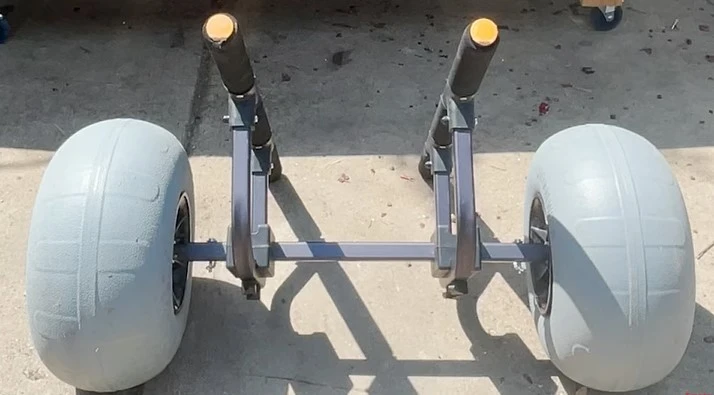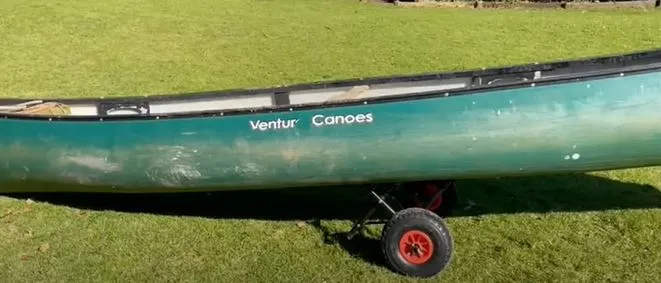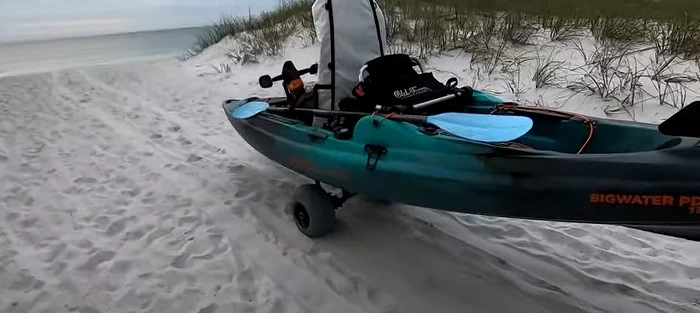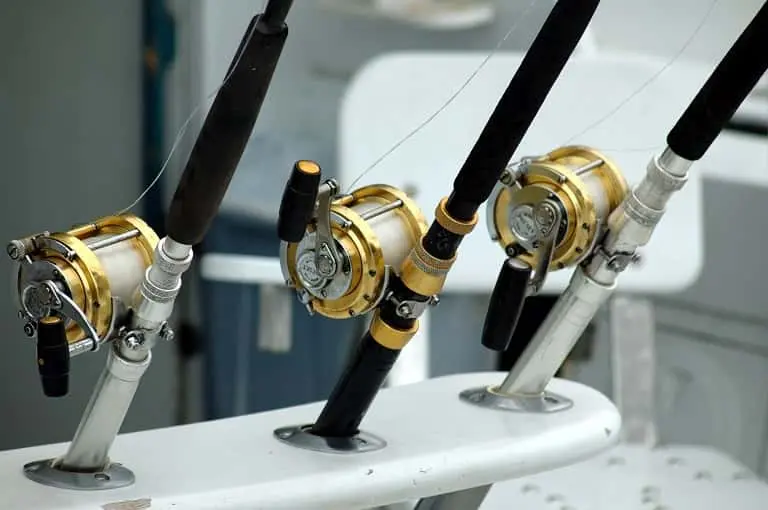Kayaking is a great way to explore the outdoors and get some exercise, but it can also be hard work if you have to carry your kayak to and from the water. A kayak cart can make this task much easier, but with so many options on the market, it can be hard to know which one to choose.
In this article, we’ll take a look at some of the key features to look for when choosing best kayak cart, including weight capacity, ease of use, and durability.
Whether you’re a recreational kayaker or a more experienced paddler, understanding what to look for in a kayak cart can help ensure that you find the perfect one for your needs.
Table of Contents
What is a kayak cart?

A kayak cart is a small, portable device that is designed to help transport a kayak from one location to another. It typically consists of a set of wheels and a frame that attaches to the kayak, allowing the kayak to be pulled or pushed along the ground.
Kayak carts are handy for moving kayaks over long distances or on rough terrain, as they allow the kayak to be moved without having to be carried.
There are a variety of different types of kayak carts available, each with its own set of features and benefits. Some kayak carts are designed to be pulled behind a person, while others can be attached to a bike or other vehicle. Some kayak carts are also designed to be collapsible, making them easy to store when not in use.
Some kayak carts are also equipped with inflatable wheels, which can help to navigate over soft sand and other challenging terrains. Other carts have wider wheels for more stability and durability.
Overall, kayak carts are an essential accessory for any kayaker who wants to easily transport their kayak to and from the water. They are a great way to save energy and time and take the hassle out of kayak transport.
What to look for in a kayak?

When looking for a kayak cart, there are several key factors to consider to ensure that you choose the right one for your needs:
- Compatibility: Make sure that the cart is compatible with the size and shape of your kayak. Some carts are designed for specific types of kayaks, such as sit-on-top or touring kayaks.
- Weight capacity: Consider the weight capacity of the cart, and make sure that it can support the weight of your kayak and any gear or supplies that you will be transporting.
- Durability: Look for a cart that is made from durable, long-lasting materials, such as aluminum or steel. This will ensure that the cart can withstand the rigors of transporting a kayak over rough terrain.
- Portability: Consider the size and weight of the cart when folded. Look for a cart that is easy to fold and transport, and that can be stored in a small space.
- Wheel type: inflatable wheels are great for soft sand and challenging terrain, while wider wheels provide stability and durability.
- Adjustability: Look for a cart with an adjustable frame to accommodate different widths of kayaks.
- Ease of use: Look for a cart that is easy to assemble, disassemble, and use. It should have a secure and stable attachment system for the kayak.
- Price: look for a cart that fits your budget, but also consider the features you need, and compare the prices with the features offered.
By considering these factors, you can ensure that you choose the right kayak cart for your needs and that you will be able to easily and safely transport your kayak to and from the water.
Why kayak cart is needed?
A kayak cart is needed for several reasons:
- Convenience: Kayak carts make it easy to transport a kayak from one location to another, whether you’re moving it from your car to the water or from one body of water to another. This can save time and energy, and make it more convenient to get your kayak to where you want to go.
- Safety: Kayak carts can help to prevent injuries by allowing you to easily and safely transport your kayak without having to lift or carry it. This is especially important if you have a heavy or large kayak, or if you have physical limitations that make it difficult to lift or carry heavy loads.
- Protection: Kayak carts can also help to protect your kayak from damage by allowing you to transport it over rough terrain or long distances without having to drag it on the ground. This can help prolong your kayak’s life and keep it in good condition.
- Accessibility: Kayak carts can help to increase accessibility to kayaking for people who have mobility issues.
- Cost-effective: Instead of buying a second kayak, you can use a kayak cart to transport the one you have to different locations, making it more cost-effective.
Overall, kayak carts are an essential accessory for any kayaker who wants to easily transport their kayak to and from the water. They offer many benefits including safety, convenience, protection, accessibility, and cost-effectiveness.
Is there any alternative to a kayak cart?
There are several alternatives to kayak carts that you can use to transport your kayak:
- Shoulder straps: Some kayaks come with built-in shoulder straps or can have them added, allowing you to carry the kayak on your shoulder. This can be a good option for shorter distances and for small or light kayaks, but it can be difficult to manage over long distances or with heavy kayaks.
- Backpack straps: Another option is to use backpack straps to carry your kayak on your back. This can be a more comfortable option for longer distances, but it can also be challenging for heavier kayaks.
- Trolleys: A kayak trolley is an alternative to a kayak cart. Trolleys are designed for easy transport of kayaks and canoes, either by hand or by attaching it to a bicycle.
- Wheeled dollies: A wheeled dolly is a device with wheels that can be attached to the kayak, allowing you to roll it along the ground.
- Kayak trailers: Kayak trailers are another option to transport kayaks, but they require a vehicle to pull them.
Each of these alternatives has its own pros and cons, and you should choose the one that best fits your needs, such as the distance you need to transport your kayak and the weight and size of the kayak. Kayak carts are the most popular and widely used option as they are the most convenient, efficient, and practical way to transport a kayak.


